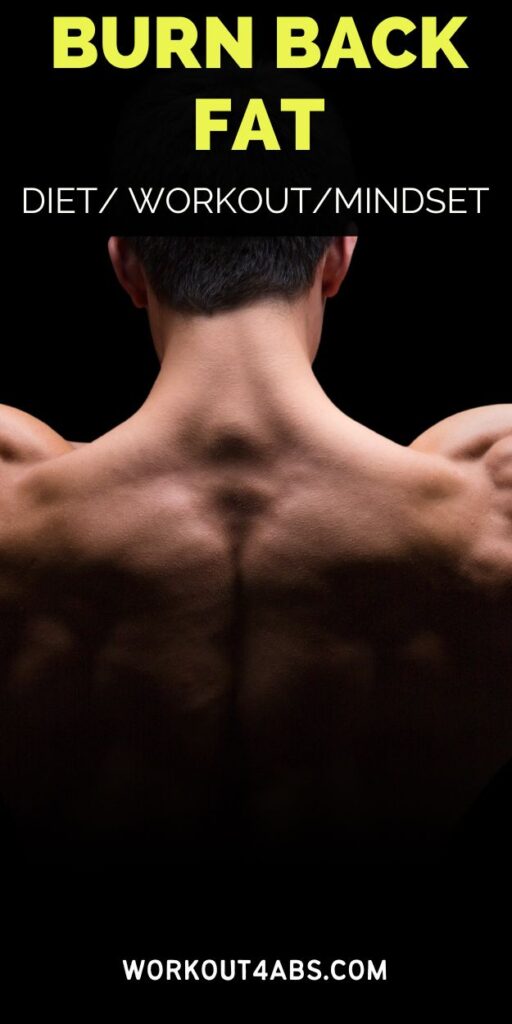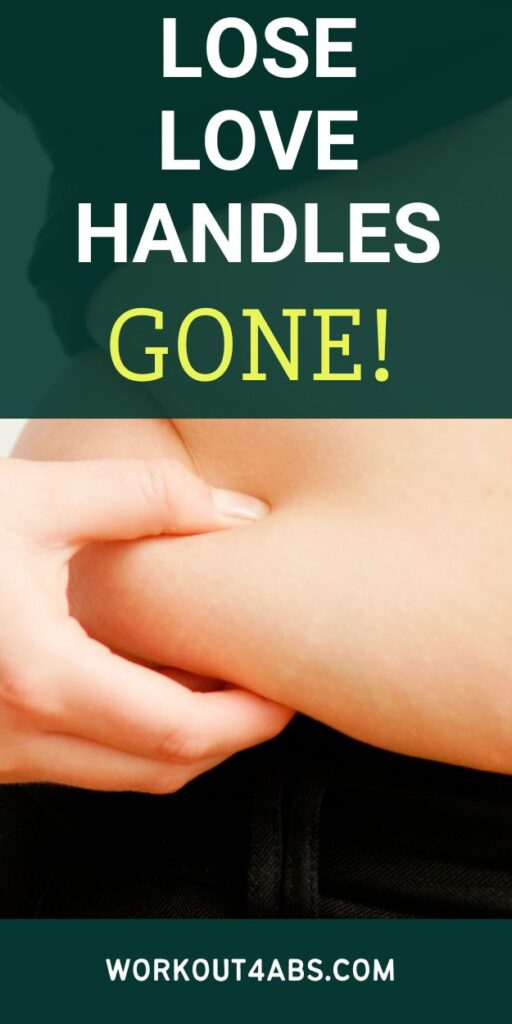Here are love handles diet tips and exercise advice to help you on your quest to shed the stubborn fat at your waistline. The winning formula involves a dynamic trio: diet, exercise, and mindset. This article delves into the holistic approach that combines nutrition, physical activity, and a positive mental attitude to help you conquer those elusive love handles and achieve lasting results.
#1 Habit to Lose Love Handles | NOW & FOREVER
If you enjoyed these tips, please save this pin to your Pinterest Board.

Training to Lose Love Handles
Exercising before your first meal, commonly referred to as fasted exercise or fasted cardio, has been a subject of interest in the fitness and weight loss community. The idea behind it is that when you exercise in a fasted state (typically in the morning before eating), your body has lower glycogen (stored carbohydrate) levels and may rely more on stored fat for energy. However, the impact on metabolism and lipid usage throughout the rest of the day and its effectiveness in losing love handle fat can vary from person to person. Here’s a breakdown of how it might work:
- Increased Fat Utilization: When you exercise in a fasted state, your body may rely more on fat as an energy source because glycogen stores are lower. This can potentially lead to increased fat utilization during the exercise session itself.
- Elevated Resting Metabolic Rate: Some studies suggest that fasted exercise may lead to a temporary increase in resting metabolic rate (RMR) post-exercise. This means you might burn slightly more calories throughout the day compared to if you had eaten before exercising.
- Insulin Sensitivity: Fasted exercise may improve insulin sensitivity, which can be beneficial for overall metabolic health. Improved insulin sensitivity can potentially help your body better regulate blood sugar levels and reduce fat storage.
- Potential Lipid Profile Improvement: There is some evidence to suggest that fasted exercise might lead to favorable changes in lipid profiles, such as increased high-density lipoprotein (HDL or “good” cholesterol) levels and decreased triglycerides. However, the effect size may be small and varies among individuals.
- Appetite Control: Exercising in a fasted state might help some people control their appetite throughout the day, making it easier to maintain a calorie deficit, which is crucial for fat loss.
- Individual Variation: It’s important to note that the response to fasted exercise can vary widely among individuals. Some people may find it beneficial for fat loss, while others may not notice significant differences compared to exercising after a meal.
- Hydration: If you choose to exercise in a fasted state, be sure to stay adequately hydrated. Dehydration can negatively impact your workout performance and overall health.
It’s essential to keep in mind that while fasted exercise might offer some potential benefits for fat loss and metabolism, it’s not a magic solution. Consistency in your exercise routine and overall diet plays a more significant role in achieving and maintaining fat loss, including targeting love handle fat.
Additionally, it’s crucial to listen to your body. Some people may feel dizzy or fatigued when exercising on an empty stomach, so it’s not suitable for everyone. If you decide to try fasted exercise, monitor how your body responds and adjust your routine accordingly.
Ultimately, the best approach to losing love handle fat is a combination of a balanced diet, regular exercise, and lifestyle changes. Consulting with a healthcare professional or fitness expert can help you create a personalized plan that aligns with your goals and preferences.
If you enjoyed these tips, please save this pin to your Pinterest Board.

Diet to Lose Love Handles
Getting rid of abdominal fat and lower back fat typically requires a combination of dietary changes, exercise, and lifestyle adjustments. It’s important to note that spot reduction, where you specifically target fat loss in one area of your body, is not effective. Instead, you should aim for overall body fat reduction, which will eventually lead to a reduction in abdominal and lower back fat. Here’s a comprehensive approach to help you achieve this:
- Calorie Deficit: The most crucial aspect of losing body fat is creating a calorie deficit, which means you consume fewer calories than you burn. Calculate your daily calorie needs and aim to eat slightly fewer calories than this number. A reasonable goal is to aim for a deficit of 300-500 calories per day.
- Balanced Diet: Focus on a well-balanced diet that includes:
- Lean Proteins: Incorporate lean sources of protein like chicken, turkey, fish, tofu, beans, and legumes. Protein helps with satiety and muscle maintenance.
- Complex Carbohydrates: Choose complex carbohydrates like whole grains, oats, brown rice, quinoa, and sweet potatoes. These provide sustained energy and keep you feeling full.
- Healthy Fats: Include sources of healthy fats such as avocados, nuts, seeds, and olive oil. These fats are important for overall health.
- Fruits and Vegetables: Consume a variety of colorful fruits and vegetables to ensure you get essential vitamins, minerals, and fiber.
- Portion Control: Pay attention to portion sizes. Even healthy foods can contribute to weight gain if you eat them in excessive quantities.
- Reduce Sugar and Processed Foods: Minimize your intake of sugary beverages, candies, and processed foods, as they are often high in empty calories and can lead to fat storage.
- Hydration: Drink plenty of water throughout the day. Sometimes thirst is mistaken for hunger.
- Meal Frequency: Some people find success with smaller, more frequent meals, while others prefer three larger meals a day. Choose an eating pattern that works best for you and helps control your appetite.
- Avoid Late-Night Snacking: Try to finish eating at least 2-3 hours before bedtime to allow your body to digest food before sleep.
- Regular Exercise: Combine your dietary changes with a consistent exercise routine. Aim for both cardiovascular exercise (like jogging or cycling) and strength training (such as weightlifting or bodyweight exercises) to burn calories and build muscle.
- High-Intensity Interval Training (HIIT): HIIT workouts are known to be effective for fat loss. They involve short bursts of intense exercise followed by brief periods of rest or low-intensity exercise.
- Adequate Sleep: Ensure you get 7-9 hours of quality sleep per night. Poor sleep can lead to weight gain and hinder fat loss.
- Stress Management: Chronic stress can lead to weight gain, particularly around the abdominal area. Practice stress-reduction techniques like yoga, meditation, or deep breathing exercises.
- Limit Alcohol Intake: Excessive alcohol consumption can contribute to weight gain, so consume it in moderation.
- Be Patient: Fat loss takes time, and results may not be immediate. Set realistic goals and monitor your progress.
Remember that genetics play a role in where your body stores fat, and some people naturally carry more weight in the abdominal and lower back areas. It’s essential to focus on overall health and body composition rather than fixating solely on specific areas. Consulting a healthcare professional or registered dietitian can provide personalized guidance tailored to your needs and goals.
Sustain a Diet Long Term
Losing love handle fat, also known as stubborn or visceral fat, can be challenging because it’s often one of the last areas on the body to shed excess fat. To successfully lose love handle fat and maintain a leaner midsection, you’ll need a long-term, sustainable approach that combines diet, exercise, and healthy lifestyle habits. Here’s a step-by-step guide:
- Commit to Long-Term Change: Understand that losing love handle fat will take time, and there are no quick fixes. Commit to making permanent changes to your diet and lifestyle.
- Create a Calorie Deficit: To lose fat, you must consume fewer calories than you burn. Calculate your daily calorie needs and aim to create a calorie deficit of 300-500 calories per day. This gradual approach is sustainable and allows for steady fat loss.
- Focus on a Balanced Diet:
- Lean Proteins: Include sources like chicken, turkey, fish, tofu, and legumes to support muscle maintenance and satiety.
- Complex Carbohydrates: Choose whole grains, oats, quinoa, and vegetables for sustained energy and fiber.
- Healthy Fats: Incorporate avocados, nuts, seeds, and olive oil in moderation for overall health.
- Limit Added Sugars and Processed Foods: Reduce or eliminate sugary beverages, candies, and processed snacks from your diet.
- Portion Control: Be mindful of portion sizes, even with healthy foods.
- Hydration: Drink plenty of water throughout the day to stay hydrated and support your metabolism.
- Regular Exercise:
- Cardiovascular Exercise: Engage in regular aerobic activities like jogging, cycling, swimming, or brisk walking to burn calories and promote overall fat loss.
- Strength Training: Incorporate strength training exercises to build lean muscle mass, which can help boost your metabolism over time.
- Core Exercises: While spot reduction isn’t effective, core exercises like planks, side planks, and Russian twists can help strengthen and tone the muscles around your midsection.
- High-Intensity Interval Training (HIIT): HIIT workouts can be particularly effective for burning fat and improving overall fitness. These involve short bursts of high-intensity exercise followed by brief periods of rest or low-intensity exercise.
- Adequate Sleep: Aim for 7-9 hours of quality sleep per night. Poor sleep can lead to weight gain and hinder fat loss.
- Stress Management: Chronic stress can lead to fat storage, especially around the abdomen. Practice stress-reduction techniques such as meditation, yoga, or deep breathing exercises.
- Limit Alcohol: Excessive alcohol consumption can contribute to weight gain, particularly around the midsection. Consume it in moderation or avoid it altogether.
- Be Patient and Persistent: Recognize that losing love handle fat may take time, and it might be the last area to slim down. Stay consistent with your diet and exercise routine, and be patient with the process.
- Consult a Professional: If you’re struggling to lose stubborn fat, consider consulting a registered dietitian or personal trainer for personalized guidance and support.
Remember that everyone’s body is different, and genetics can play a role in where you store and lose fat. While it may be challenging to lose love handle fat, with the right approach and persistence, you can achieve your fat loss goals and maintain a healthier midsection over the long term.
Adaptive Thermogenesis
Adaptive thermogenesis is a term used to describe the body’s ability to adjust its metabolic rate in response to changes in calorie intake and energy expenditure. It plays a role in weight loss and can impact the process of losing love handle fat. Here’s how adaptive thermogenesis fits into the equation:
- Metabolic Rate Adjustment: When you create a calorie deficit by consuming fewer calories than your body needs (as is typically the case when trying to lose weight and body fat), your body responds by reducing its metabolic rate. This is a survival mechanism that helps conserve energy during times of perceived food scarcity.
- Slower Weight Loss: Adaptive thermogenesis can slow down the rate at which you lose weight and body fat. As your body adapts to the reduced calorie intake, it becomes more efficient at utilizing the available energy, which can make it harder to continue losing weight at the same rate.
- Stubborn Fat Storage: Love handle fat, often referred to as visceral fat, is known for being stubborn and resistant to fat loss. When your body experiences adaptive thermogenesis, it tends to prioritize the preservation of fat stores in certain areas, including the abdominal region, which includes the love handles.
- Plateaus: Adaptive thermogenesis can contribute to weight loss plateaus, where your progress slows or even stalls. During plateaus, it may seem like you’re doing everything right with your diet and exercise, but your body has adapted to the lower calorie intake, making further fat loss more challenging.
To address adaptive thermogenesis and continue making progress in losing love handle fat:
- Gradual Calorie Reduction: Rather than drastically cutting calories, aim for a gradual reduction in calorie intake. This can help minimize the body’s response to adaptive thermogenesis.
- Intermittent Calorie Cycling: Some people find success by occasionally increasing calorie intake for a day or two (a process known as refeeding) to “reset” their metabolism. This can be done by strategically incorporating higher-calorie days into your diet plan.
- Adjustment of Exercise Routine: Continuously challenge your body with different types of exercises and intensity levels. This can help prevent metabolic adaptation and encourage the burning of stubborn fat.
- Patience and Persistence: Understand that weight loss, especially in stubborn areas like the love handles, can take time. Be patient and stay consistent with your healthy lifestyle habits.
- Consult a Professional: If you’re experiencing significant challenges in losing love handle fat and suspect adaptive thermogenesis is a factor, consider consulting a registered dietitian or personal trainer. They can provide personalized guidance and help you develop strategies to overcome plateaus and reach your goals.
It’s essential to approach weight loss and fat loss with a long-term perspective and focus on overall health and well-being rather than fixating solely on specific areas of the body. Keep in mind that genetics also play a role in fat storage patterns, and some individuals may naturally carry more fat in certain areas.
Mindset to Lose Love Handles
Incorporating fat loss and fitness into your daily routine for the rest of your life is essential for achieving and maintaining the goal of losing love handle fat (stubborn abdominal fat) and overall body fat reduction. Here’s why long-term commitment is crucial:
- Sustainability: Losing love handle fat and achieving a healthier body composition isn’t just about short-term results; it’s about making sustainable lifestyle changes. Crash diets and extreme workout routines are typically not sustainable, and any weight lost through such methods is often regained once normal habits resume. Consistency is key to long-term success.
- Healthy Habits: By making fitness and a balanced diet a daily part of your life, you establish healthy habits that benefit your overall well-being. Regular exercise and a nutritious diet not only help with fat loss but also contribute to improved cardiovascular health, better mental well-being, and reduced risk of chronic diseases.
- Metabolic Adaptation: As you work toward fat loss, your body may adapt by slowing down its metabolic rate, which can make further fat loss more challenging. Consistency in exercise and a well-balanced diet can help mitigate this adaptation by maintaining a healthy metabolism.
- Maintenance: Once you’ve achieved your fat loss goals, maintaining that progress requires ongoing effort. Continuing to prioritize fitness and a balanced diet helps you prevent weight regain and ensures that the love handle fat doesn’t return.
- Long-Term Health: Reducing love handle fat isn’t just about aesthetics; it’s about improving your long-term health. Excess abdominal fat is associated with a higher risk of heart disease, diabetes, and other health issues. Maintaining a healthy weight and fitness level is essential for reducing these health risks.
- Body Composition: Fitness isn’t just about losing fat; it’s also about building and maintaining muscle. Muscle is metabolically active tissue, meaning it burns more calories at rest than fat does. By incorporating strength training and resistance exercises into your routine, you can improve your body composition and further support fat loss and long-term weight maintenance.
- Mental Well-Being: Regular exercise has been shown to have a positive impact on mental health, reducing stress, anxiety, and depression. Including fitness as a daily habit can contribute to your overall sense of well-being and happiness.
- Adaptation: Over time, your body adapts to exercise, becoming more efficient and effective. By maintaining a consistent fitness routine, you can continually challenge your body and avoid plateaus in your progress.
- Enjoyment: Finding physical activities and healthy foods that you enjoy and can sustain over the long term is key to making them a permanent part of your daily life. This makes the journey toward fat loss and fitness more enjoyable and less of a chore.
- Setting an Example: Your commitment to a healthy lifestyle can inspire those around you, including friends and family, to make positive changes in their own lives.
Remember that consistency, patience, and a focus on overall health are key when integrating fat loss and fitness into your daily routine. Seek guidance from fitness professionals or registered dietitians to create a personalized and sustainable plan that works for you. Ultimately, this long-term approach will help you not only lose love handle fat but also maintain a healthier, happier life.
If you enjoyed these tips, please save this pin to your Pinterest Board.

Home › Aesthetic Body Plan ›Love Handles Diet